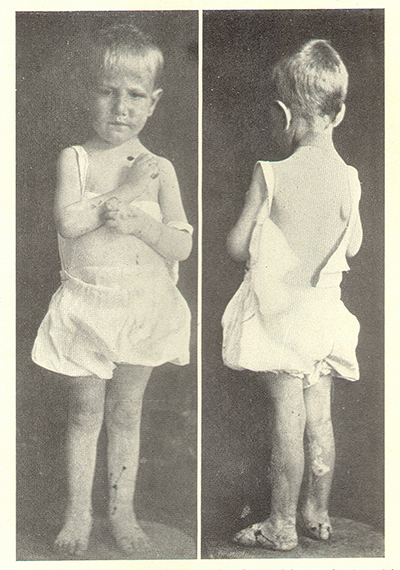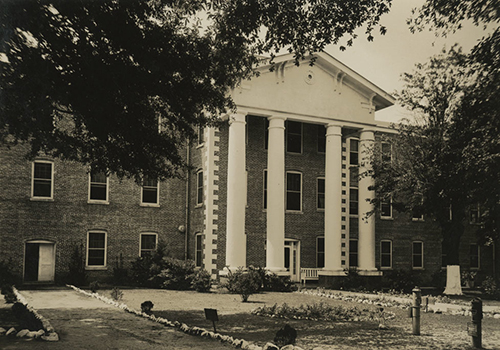 Shown here are the dermatologic symptoms characteristic of the disease exhibited in a child from Mobile.Shortly after Dr. Searcy’s 1906 discovery of the pellagra epidemic in Alabama, area physicians began to dialogue about the etiology and treatment of this “scourge of the South.” The venue for much of this discussion was the Medical Association of Alabama annual meeting, and various theories were published in the transactions of that body, as well as in other regional medical publications. From the descriptions of the articles below, it is apparent that opinions regarding pellagra were wide-ranging. Some thought it contagious, others agreed with the traditional view of spoiled or toxic cornmeal, and some looked to diet and living conditions. Mosquito vectors and sun exposure were also mentioned. Suggested treatments ranged from blood transfusion to arsenic therapy and drug treatments. Despite their disagreement, what is apparent from these articles is that Alabama physicians were valiantly struggling to find a cure for this virulent disease.
Shown here are the dermatologic symptoms characteristic of the disease exhibited in a child from Mobile.Shortly after Dr. Searcy’s 1906 discovery of the pellagra epidemic in Alabama, area physicians began to dialogue about the etiology and treatment of this “scourge of the South.” The venue for much of this discussion was the Medical Association of Alabama annual meeting, and various theories were published in the transactions of that body, as well as in other regional medical publications. From the descriptions of the articles below, it is apparent that opinions regarding pellagra were wide-ranging. Some thought it contagious, others agreed with the traditional view of spoiled or toxic cornmeal, and some looked to diet and living conditions. Mosquito vectors and sun exposure were also mentioned. Suggested treatments ranged from blood transfusion to arsenic therapy and drug treatments. Despite their disagreement, what is apparent from these articles is that Alabama physicians were valiantly struggling to find a cure for this virulent disease.
Articles by Alabama Physicians (in chronological order)
Leach, Sydney. “A Case of Pellagra.” Transactions of the Medical Association of the State of Alabama (April 1908): 446-452.
Leach believed pellagra was “due to intoxication from the existing damaged maze, corn which has not matured, not been properly dried or meal which has not been kept dry after grinding.” Leach adds that poverty, hard labor and high exposure to the sun are “predisposing causes.” He suggests a “prophylactic” treatment with “tonics of iron and quinine,” and concludes with a case study and discussion.
Cole, H. P. "The Transfusion of Blood as a Therapeutic Agent with Report of Transfusion in a Case of Pellagra." Reprint from The Southern Medical Journal (April 1909): 631-638.
Dr. Cole's article reports on the "successful" treatment by blood transfusion of a pellagra patient at the Mt. Vernon Hospital. In this case, blood from a recovered pellagra patient was given to one suffering the advanced stages of the disease. The article also discusses more generally the technique of blood transfusion and the theoretical basis for its use in fighting disease.
McCafferty, E. L. "Pellagra Among the Colored Insane at the Mt. Vernon Hospital." Reprint from the Gulf States Journal of Medicine and Surgery and Mobile Medical and Surgical Journal (April 1909).
 Mount Vernon Hospital for the Colored Insane, near Mobile, Alabama, where Dr. George H. Searcy first recognized epidemic pellagra in the U.S.In this article, McCafferty gives an update on the pellagra cases at the Mt. Vernon Hospital since Searcy's 1907 article. Detailed incidence and mortality lists are provided. He describes the results of several experimental tests and postmortems conducted at that hospital. He also notes patient responses to various treatments, especially the "success" of blood transfusion (also reported in H. P. Cole's article).
Mount Vernon Hospital for the Colored Insane, near Mobile, Alabama, where Dr. George H. Searcy first recognized epidemic pellagra in the U.S.In this article, McCafferty gives an update on the pellagra cases at the Mt. Vernon Hospital since Searcy's 1907 article. Detailed incidence and mortality lists are provided. He describes the results of several experimental tests and postmortems conducted at that hospital. He also notes patient responses to various treatments, especially the "success" of blood transfusion (also reported in H. P. Cole's article).
Randolph, James H. "Some Notes on Pellagra and Pellagrins, With Report of Cases." The Mobile Medical and Surgical Journal (February 1909): 65-87.
This paper, read before the Southern Medical Association in 1908, gives an extensive overview of the current knowledge of pellagra up to that date. Discovered in epidemic proportions in the U. S. just two years prior, this article provided Southern physicians current information regarding pellagra's symptoms, historical distribution, etiology, pathology, diagnosis, prognosis, and treatment, as well as numerous case descriptions.
Hand, Samuel P. “Pellagra.” Transactions of the Medical Association of the State of Alabama (April 1910): 330-335.
This paper was written at the request of Medical Association of Alabama President Wooten Moore Wilkerson. It presents 12 case studies.
Mason, E. Marvin. “Pellagra.” Transactions of the Medical Association of the State of Alabama (April 1910): 336-349.
This paper presents a history of the disease up to George H. Searcy’s report. Mason notes that its “etiology remains obscure,” and that Guido Tizzoni’s claim of a bacterial basis remains unconfirmed. The belief that it is contagious, Mason insists, is “without foundation.” It proceeds with a detailed pathological report. Treatment suggestions are offered. Discussion follows.
Wilkerson, Wooten Moore. “Annual Message of the President.” Transactions of the Medical Association of the State of Alabama (April 1910): 12-13.
The President notes that pellagra was a significant health concern for the state during the year and refers to the “mode of infection” and cure.
Moody, Earle F. “The Treatment of Pellagra.” Transactions of the Medical Association of the State of Alabama (April 1914): 247-265.
This paper gives a detailed summary of treatment recommendations, noting to “do everything possible to aid nutrition;” lengthy discussion follows. It includes, “Information for the Public About Pellagra.” Mill village studies of Spartanburg, NC (the Thompson-McFadden Commission, 1912) are referenced, noting the use of milk reduced incidents of the disease and rules out “corn meal as an essential cause of pellagra.” The possibility of an insect vector is also discussed.
Pruett, T. J. “Is Pellagra a Preventable Disease?” Transactions of the Medical Association of the State of Alabama (April 1914): 237-242.
Pruett addresses pellagra prevention and notes that the unresolved nature of its etiology makes confident assertions about the topic difficult. He believes that arsenic therapy may have some benefit, and refers to the Thompson-McFadden Commission, criticizing the infection theory by warning against too hasty and abandonment of the spoiled maize or spoilage theory in general.
Ray, J. W. “Some Possible Causes of Failure in the Treatment of Pellagra.” Transactions of the Medical Association of the State of Alabama (April 1914): 243-246.
Ray notes that no “routine treatment” is currently available and that pellagra is very hard to diagnose in its early stages. He observes that early diagnosis is important and relies upon drug therapy, but offers no specific recommendations.
